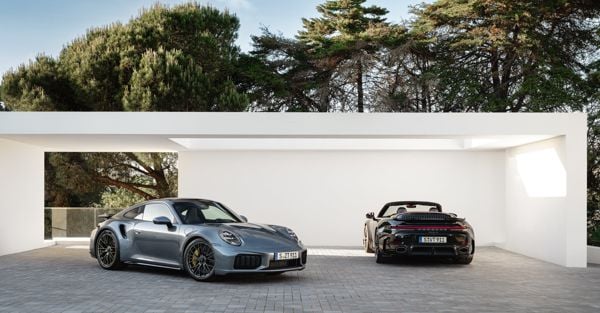Porsche 911 Turbo S, the most powerful ever, is hybrid

Having reached 50 years with seven generations, the 911 Turbo continues to amaze with the fourth generation of the S version, which has always been at the top of the most iconic Porsche family. Indeed, it's the Porsche par excellence. The new Turbo S, debuting at the Munich Motor Show, extends the legacy of the 992.2 generation by leveraging the sophisticated T-Hybrid technology developed by Porsche. This unparalleled solution, which debuted with the current 911 Carrera GTS and was specifically evolved for the Turbo S, aims even higher, true to the lineage's tradition. The new Turbo S offers higher performance and even more effective dynamism than its predecessor, while still offering a character suited to both everyday use and extreme driving. Equally fitting, it debuts in the Coupé and Cabriolet versions, which are available to order now at prices of €280,000 and €295,000, respectively. In short, they too are at the top of the 911 range.
Photo gallery 10 photos
The powertrain, with 711 hp (511 kW), more than 60 hp (60 kW) more than the previous Turbo S, makes this new 911 the most powerful ever produced. Along with this figure, the electrified, supercharged 3.6-liter flat-six also delivers 800 Nm of torque, available across an extremely wide rev range from 2,300 to 6,000 rpm. The power curve is also characterized by an unusually broad peak, with the maximum torque being available between 6,500 and 7,000 rpm. The powertrain is complemented by the sophisticated T-Hybrid technology with a 400-volt high-voltage system and a high-voltage battery with a capacity of 1.9 kWh, which debuted in the Carrera GTS and has been refined for the Turbo S. In practice, there are two turbochargers, each with an electric motor positioned between the turbine and the impeller, sized specifically for this model. The two eTurbo engines not only significantly increase performance, but also improve responsiveness and spontaneous power delivery. Furthermore, an electric motor is integrated into the eight-speed dual-clutch transmission and transmits power to the all-wheel drive. The new engine propels the Turbo S to a top speed of up to 322 km/h, allowing it to reach 100 km/h in 2.5 seconds and 200 km/h in 8.4 seconds (half a second faster than the previous model) with a combined cycle fuel consumption of 11.8 liters per 100 kilometers.

Despite weighing 85 kg more than its predecessor, the new Turbo S proved significantly faster on the Green Hell of the Nürburgring, completing the 22.8-kilometer (14.0-mile) circuit in under 7 minutes and 4 seconds, or nearly 14 seconds faster. This result is the result of numerous technological innovations developed for the most powerful 911 ever. The setup includes the electrohydraulically controlled ehPddc suspension, which reduces body roll, increases agility when entering and exiting corners, and enhances stability, while also improving handling and comfort. Furthermore, the suspension is complemented by wider rear wheels than before, which, together with the front wheels, are shod with a new generation of tires, and the carbon-ceramic braking system, derived from those found on Porsche race cars, features larger discs—in fact, the largest ever fitted to a two-door Porsche. Another significant contribution to the dynamism and overall efficiency of the new 911 Turbo S comes from intelligent active aerodynamics. It is defined by the vertically arranged active air vents at the front, the active front diffuser and the variable profile of the front spoiler, and the extending and tilting rear wing, inherited from the previous model. The system optimally directs cooling air to the brakes and transmission cooling units, intelligently reducing lift or drag depending on the driving situation. The drag coefficient of the Coupé version is 10% lower than that of the previous model when all active aerodynamic elements are in their most efficient position. Finally, by setting the Wet mode, the active aerodynamics improves braking performance on wet surfaces, because the front air vents close to protect the front discs as much as possible from water spray.
ilsole24ore





